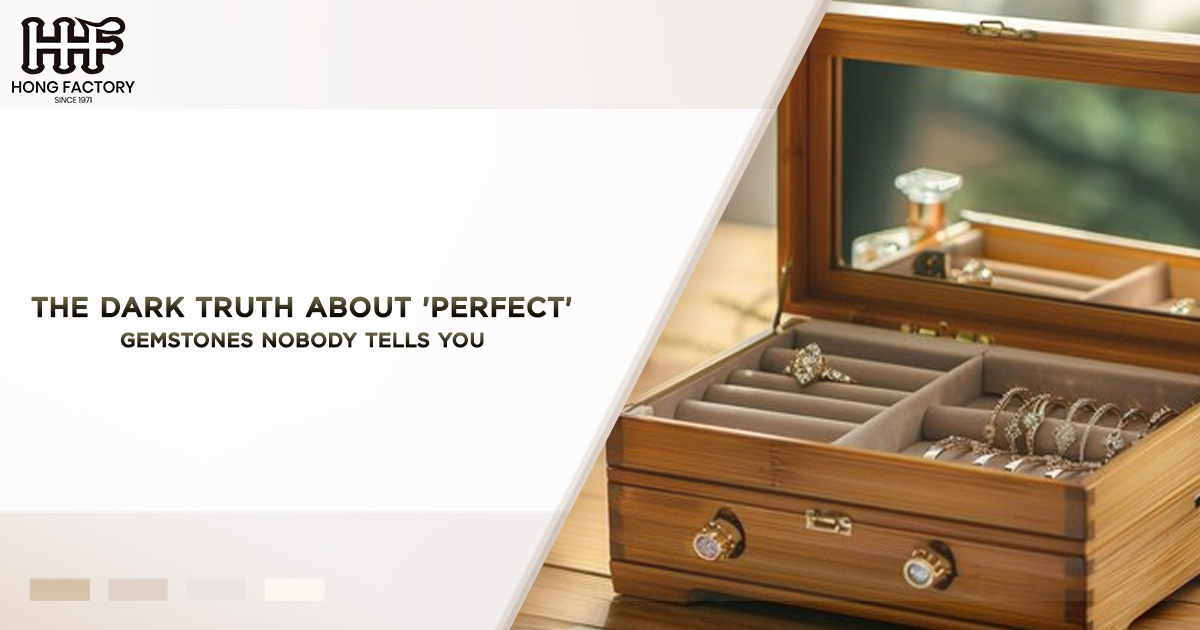Gemstones have long captivated human imagination with their dazzling beauty and rarity. From ancient times to modern-day fashion, the allure of gems like diamonds, rubies, sapphires, and emeralds continues to grow.
However, what many enthusiasts and buyers might not realize is that the gemstone industry harbors some hidden, sometimes unsettling practices. This article delves into the dark truth about ‘perfect’ gemstones, highlighting the often-overlooked issues related to natural gems, gem enhancement, ethical sourcing, and gem authenticity.
Natural Gems : Not Always What They Seem
Natural gems are typically regarded as the purist’s choice, celebrated for their unique imperfections and natural aura. However, the term “natural” can be more complicated than it appears. While natural gems are indeed sourced from the earth without synthetic intervention, they are not always as untouched and pure as consumers might assume.
The Illusion of Perfection
Most gemstones found in retail do not naturally exhibit the perfect color, clarity, or brilliance that consumers desire. Nature rarely produces flawless specimens, which means that most stones must undergo some form of enhancement to meet market expectations. The industry often portrays these gems as naturally perfect, obscuring the reality that their beauty is often the result of human intervention.
Gem Enhancement : The Secret Behind the Sparkle
Gem enhancement is a widespread practice designed to improve the appearance of gemstones, making them more visually appealing and, consequently, more valuable. These enhancements can vary from simple treatments to complex procedures that can significantly alter the stone’s original properties.
Common Enhancement Techniques
- Heat Treatment : The most common enhancement, especially for sapphires and rubies, involves heating the stone to improve color and clarity. While this method is generally accepted in the industry, it can significantly alter the natural state of a gem.
- Fracture Filling : Used predominantly for diamonds, this process involves filling fractures within the stone with a colorless substance to enhance clarity. The treatment can make a stone appear more flawless than it naturally is.
- Irradiation : This technique involves exposing gemstones to radiation to change or enhance color. It is often used with stones like topaz and diamonds.
- Dyeing : Some porous stones, like jade and certain types of quartz, are dyed to enhance their color. Over time, the dye may fade, revealing the stone’s true, less vibrant hue.
These treatments raise questions about the authenticity of the gems and whether they should be sold at the same value as untreated stones. Unfortunately, not all sellers disclose these enhancements to buyers, leaving them in the dark about the true nature of their purchase.
Ethical Sourcing : The Shadowy Supply Chain
In recent years, there has been increased awareness and concern over ethical sourcing in the gemstone industry. The supply chain for gems is often murky, and the journey from mine to market can involve labor issues, environmental harm, and unethical practices.
The Troubles with Traceability
Many gemstones are sourced from regions where working conditions are hazardous, and miners are underpaid. Furthermore, the lack of transparency in the supply chain makes it difficult to ensure that gems are sourced ethically.
- Conflict Stones : Some gems, like conflict diamonds, are mined in war zones and sold to finance armed conflict. While initiatives like the Kimberley Process have been established to prevent such stones from entering the market, enforcement can be inconsistent.
- Environmental Impact : Gem mining can lead to severe environmental degradation, including deforestation, soil erosion, and water pollution. Without proper regulation, the extraction process can wreak havoc on local ecosystems.
- Fair Compensation : In many gem-producing regions, workers receive minimal wages and lack basic labor rights. The disparity between the profits made by retailers and the earnings of miners is vast.
Efforts are being made by various organizations to promote and ensure ethical sourcing. However, the lack of standardized regulations means that the burden often falls on consumers to research and choose ethical options.
Gem Authenticity : Truth vs. Deception
With the market flooded with imitations, determining gem authenticity has become a significant concern for buyers. The line between natural and synthetic stones is increasingly blurred, making it challenging to tell genuine stones apart from their artificial counterparts.
Methods of Deception
- Synthetic Stones : These are man-made gems created in laboratories that mimic the properties of natural gems. While they offer a more affordable option, they are often misleadingly marketed as “real” gems.
- Simulants : Materials like cubic zirconia and moissanite are used to simulate the appearance of diamonds and other gemstones. While visually similar, they do not possess the same properties and are significantly cheaper to produce.
- Mislabeling : Unscrupulous dealers may mislabel stones, passing off lesser-quality gems as more valuable ones. For instance, a lower-quality ruby might be labeled as a premium-grade stone.
To combat these issues, buyers should seek gems with certification from reputable gemological laboratories. These certificates detail the stone’s quality, authenticity, and any treatments performed.
Navigating the Gemstone Market
For consumers, the key to navigating the gemstone market lies in education and vigilance. Here are some actionable steps to ensure a wise purchase
- Research : Understand the type of gem you are interested in, including common treatments and enhancements. Familiarize yourself with industry terms and practices.
- Ask Questions : When buying a gemstone, inquire about its history, treatments, and origin. A reputable dealer should be transparent and willing to provide this information.
- Certification : Always request a certificate from a well-established laboratory, which guarantees the authenticity and quality of the gem.
- Ethical Choices : Support companies and retailers that are committed to ethical sourcing and transparent supply chains. Look for certifications and partnerships with organizations that promote fair trade and sustainable practices.
Conclusion
While gemstones will always hold a timeless appeal, it is crucial for consumers to be aware of the less glamorous aspects of the industry. By understanding the common practices of gem enhancement, the importance of ethical sourcing, and the challenges of ensuring gem authenticity, buyers can make informed decisions that align with their values.
As awareness grows, the hope is that the industry will continue to evolve towards greater transparency and sustainability, ensuring that the beauty of gemstones can be appreciated without compromise.




